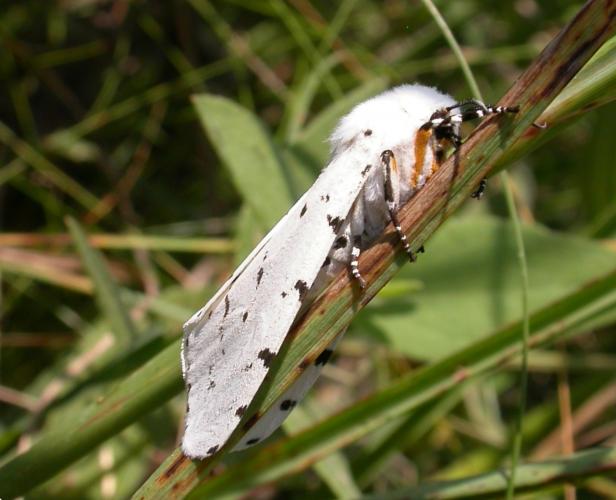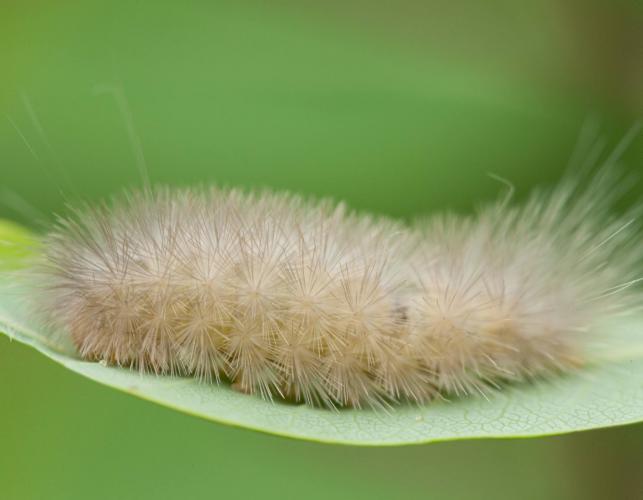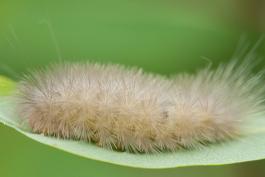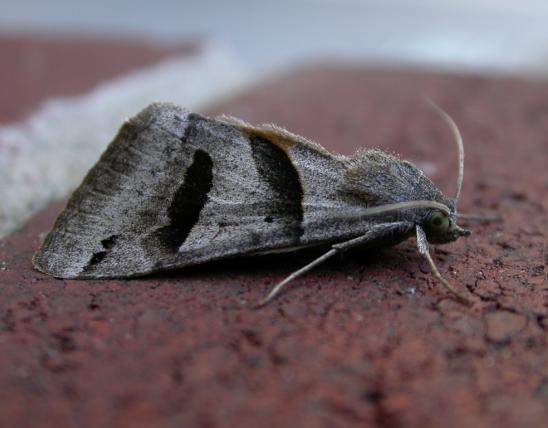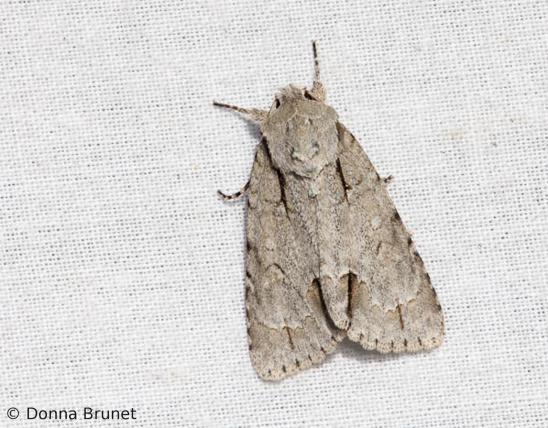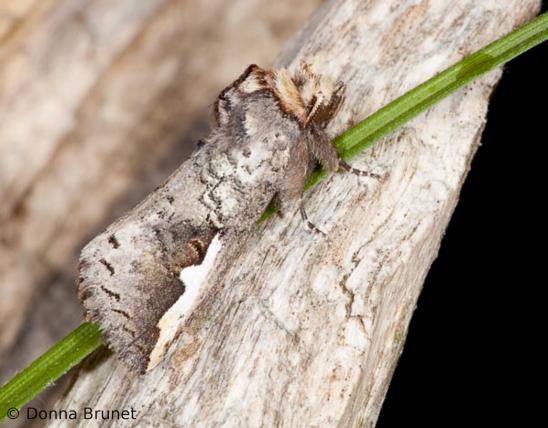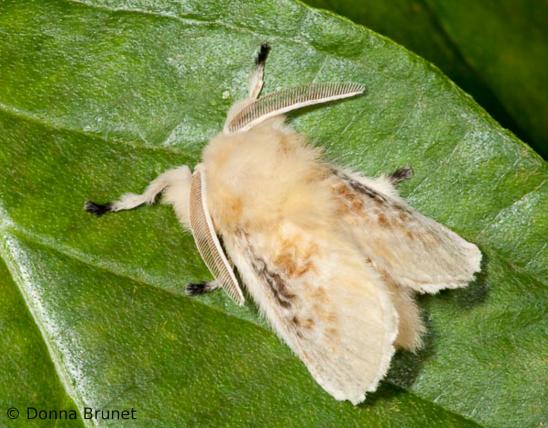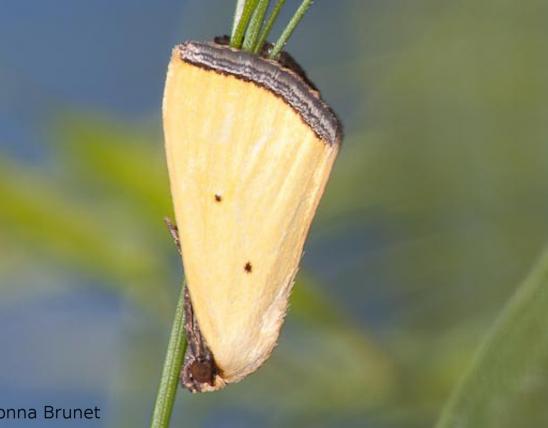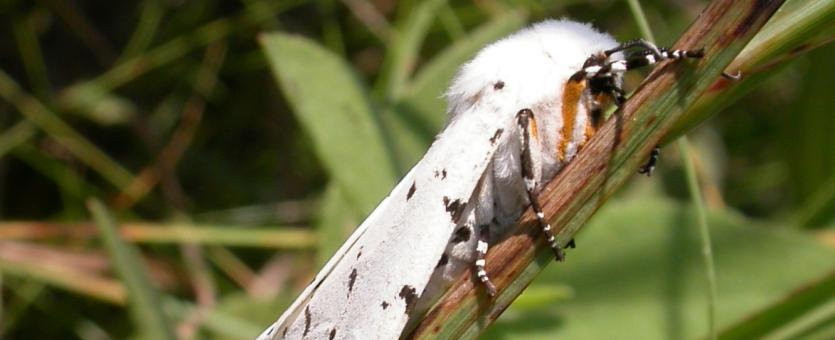
Forewings of adults are white with black spots. The amount and size of the black spots varies, but the spots are configured in a way that, if you connected them, they would form lines and bands. There are usually 5 fairly prominent spots evenly spaced along the costa (leading edge) of the forewing. Some individuals lack spots completely. Hindwings are different in the two sexes: on males, they are yellowish-orange, and on females, they are white. Both sexes usually have about 3 or 4 black spots on the hindwings.
The bodies of adults are white on the head and thorax, with the abdomen orangish-yellow. On females, the tip of the abdomen is white.
Caterpillars are mottled with yellow and brown and are hairy like a woolly worm. The long, bristly hairs arise from orange or black, raised tubercles. The colors of the hairs can vary quite a bit. The hairs can be all grayish-white, yellowish, reddish brown, or blackish. One common coloration has grayish brown hairs along the top side and reddish brown hairs on the sides. The caterpillars typically walk very quickly.
Similar species: A number of moths look confusingly similar to this species. The Virginian tiger moth (Spilosoma virginica) adult is very similar, but its body lacks the different white versus orange regions; instead, the abdomen is mainly white, with a black dot on the top of each abdominal segments, and some orangish bandlike markings separating the different segments.
The Virginian tiger moth’s caterpillar looks similar, too. The salt marsh caterpillar, however, has noticeably longer hairs at the front and end of the body, especially at the rear, while the Virginian’s hairs are long, soft, and vary considerably in length over the whole body. In both species, the color of caterpillar hairs can vary tremendously, so hair color is not a good clue.
Other similar moths in our region include the agreeable tiger moth (Spilosoma congrua), which has a pure white abdomen, and the fall webworm moth (Hyphantria cunea). The color patterns on the abdomen should help separate these from salt marsh moths. After that, however, you need to look at color patterns of the legs and other arcane characteristics. Fortunately, many Internet resources exist to help you with these fine points.
Wingspan: 1¾–2¾ inches.
Statewide.
Habitat and Conservation
This species is typically found in fairly open areas, including openings in woods, thickets, farm fields, grasslands, and marshes. It is called the “salt marsh moth” because it is common in coastal salt marshes (tidal marshes) along Pacific, Atlantic, and Gulf coasts — but Missouri lacks those habitats.
People often see the fast, active larvae hustling across the ground as they disperse, looking for suitable food.
Adults are nocturnal and are frequently found at lights at night.
Food
The caterpillars eat foliage of a wide variety of food plants, both woody and nonwoody. They can be pests on several garden and crop plants, including members of the cabbage family, corn, asparagus, peas and beans, lettuce, strawberries, beets, clover and alfalfa, potatoes, tomatoes, tobacco, cotton, apple trees, soybeans, and more.
Crops are not the whole story by far. Many common agricultural weeds are among their favorite food plants: pigweed (Amaranthus); members of the dogbane/milkweed family; bonesets (Eupatorium); nightshades, including ground cherry (Physalis); and mallows (including Anoda).
Status
Breeding resident.
Life Cycle
There are three generations in Missouri, with adults flying in our state from early April through October. This species overwinters in the pupal stage, protected by a large cocoon made from silk and from the hairs of the caterpillar. Adult moths emerge in spring. Females deposit eggs in clusters of 400 to 1,200 on the leaves of suitable host plants. The eggs hatch within a week, and the caterpillars eat, grow, and molt a number of times before they’re ready to pupate. When young, the caterpillars are gregarious (feed in groups). As they grow larger and hungrier, they travel across ground to find more food. They may spend 20 to 45 days as caterpillars before pupating.
Human Connections
When abundant, the caterpillars can be crop pests. In some regions, salt marsh caterpillars have been reported moving to the edges of irrigated crop fields when the weeds along the margins of the fields dry up; in this situation, they can inflict damage to the crop field edges.
Oddly enough, the name of this species came from an early report from New England where the caterpillars were said to be feeding heavily on saltgrasses growing in a hayfield. Generally speaking, this species prefers not to eat grasses or grasslike plants, but instead prefers a wide variety of broadleaf plants and “weeds.”
This is one of the species of woolly bear–type caterpillars we frequently see walking across roads in autumn. These are large larvae looking either for more food or for a safe place in which to spin a cocoon and pupate during winter.
Ecosystem Connections
To pass your genes into the next generation, you have to survive and reproduce. Adult male salt marsh moths (and many other types of moths) have a pair of taillike structures called coremata that can be inflated and everted out of the abdomen tip. These coremata have hairs on them that give off pheromones (scents) that attract females. If you gently squeeze a male’s abdomen (remember, males have the orangish hindwings), the coremata may poke out.
As an aid to survival, salt marsh moths have a defensive behavior involving icky smelling (and no doubt, bad-tasting) chemicals: when harassed, an adult moth typically raises its wings and wafts this acrid odor around.
The caterpillars are often parasitized by tachinid flies, which deposit eggs on the larvae. Ichneumons and other parasitic wasps also eat the larvae as well as the eggs. Other animals that eat the caterpillars include assassin bugs and the larvae of lady beetles. If the bristly hairs and possible toxic or bad-tasting chemicals don’t deter them, birds, amphibians, reptiles, and small mammals may eat them as well.
